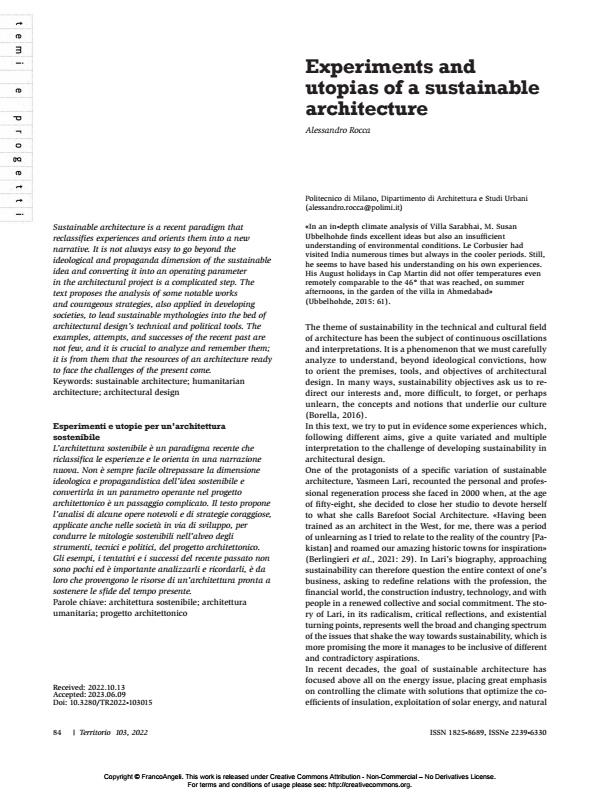Experiments and utopias of a sustainable architecture
Journal title TERRITORIO
Author/s Alessandro Rocca
Publishing Year 2023 Issue 2022/103 Language English
Pages 5 P. 84-88 File size 235 KB
DOI 10.3280/TR2023-103015
DOI is like a bar code for intellectual property: to have more infomation
click here
Below, you can see the article first page
If you want to buy this article in PDF format, you can do it, following the instructions to buy download credits

FrancoAngeli is member of Publishers International Linking Association, Inc (PILA), a not-for-profit association which run the CrossRef service enabling links to and from online scholarly content.
Sustainable architecture is a recent paradigm that reclassifies experiences and orients them into a new narrative. It is not always easy to go beyond the ideological and propaganda dimension of the sustainable idea and converting it into an operating parameter in the architectural project is a complicated step. The text proposes the analysis of some notable works and courageous strategies, also applied in developing societies, to lead sustainable mythologies into the bed of architectural design’s technical and political tools. The examples, attempts, and successes of the recent past are not few, and it is crucial to analyze and remember them; it is from them that the resources of an architecture ready to face the challenges of the present come.
Keywords: sustainable architecture; humanitarian architecture; architectural design
- Architekturburo Reinberg zt GmbH, 2020, Georg W. Reinberg: Architek- tur Für Eine Solare Zukunft/ Architecture for a Solar Future. Basel: Birkhäuser.
- Berlingieri F., Corradi E., Cozza C., Forino I., 2021, Yasmeen Lari. An architect. Milan-Turin: Pearson Italia.
- Borella G., 2016, Per un’architettura terrestre. Siracusa: LetteraVentidue. Bovati M., Reinberg G.W., 2017, Il clima come fondamento del progetto. Milano: Marinotti.
- Carpo M., 2011, The Alphabet and the Algorithm. Cambridge, ma: the mit Press. Franzelin A., 2007, «Marketing for the passive house? Potentials with reference to the experiences with the South Tyrolean Klimahaus». Atti di 11th International Conference on Passive Houses, Bregenz, Austria, Darmstadt, Germany (Passivhaus Institut), 179-184.
- McKnight J.M., 2016, «Exclusive: Architecture for Humanity Founders and Board Members Sued for $3 Million», Architectural Record, 11/07/2016, www.architecturalrecord.com/articles/11787-exclusive-architec- ture-for-humanity-founders-and-board-members-sued-for-3-million (access: 2022.03.29).
- Le Corbusier, 1925, Vers une architecture. Paris: Crès.
- Murcutt G., 2019, «Marika-Alderton House. 1990–1994». Atlas of Places. www.atlasofplaces.com/architecture/marika-alderton-house/ (access: 2022.03.29).
- Olivero C., Kessel L., 2014, a cura di, Sostenibilità CasaClima: protocolli e realizzazioni. Torino: Utet scienze tecniche.
- Rocca A., 2007, Natural Architecture. New York: Princeton Architectural Press.
- Rocca A., 2010, Architettura low cost/low tech. Invenzioni e strategie di un’avanguardia a bassa risoluzione. Schio: Sassi.
- Sarah Wigglesworth Architects, 2002, «House, Islington». Architectural Review, 1: 64-67.
- Schmitt Y., Troi A., Pichler G., Sparber W., 2007, «KlimaHaus CasaClima
- -a regional energy certification system stimulates low energy architec- ture». Proceedings of PLEA2007 -The 24th Conference on Passive and Low Energy Architecture, Singapore, 22-24 November.
- Ubbelhohde M.S., 2015, «La danza di un giorno d’estate. Casa Sarabhai di Le Corbusier a Ahmedabad, India». In: Pozzi C., Il clima come materiale da costruzione. Melfi: Libria, 53-79.
- Walker A., 2016, «Architecture for Humanity Founders and Board Members Face $3M Lawsuit Alleging Mismanagement of Funds». Curbed, 14 July, https://archive.curbed.com/2016/7/14/12161102/architecture-for-hu- manity-lawsuit-cameron-sinclair-kate-stohr (access: 2022.03.29).
- Zanotto F., 2020, Circular Architecture. Siracusa: LetteraVentidue.
Alessandro Rocca, Experiments and utopias of a sustainable architecture in "TERRITORIO" 103/2022, pp 84-88, DOI: 10.3280/TR2023-103015